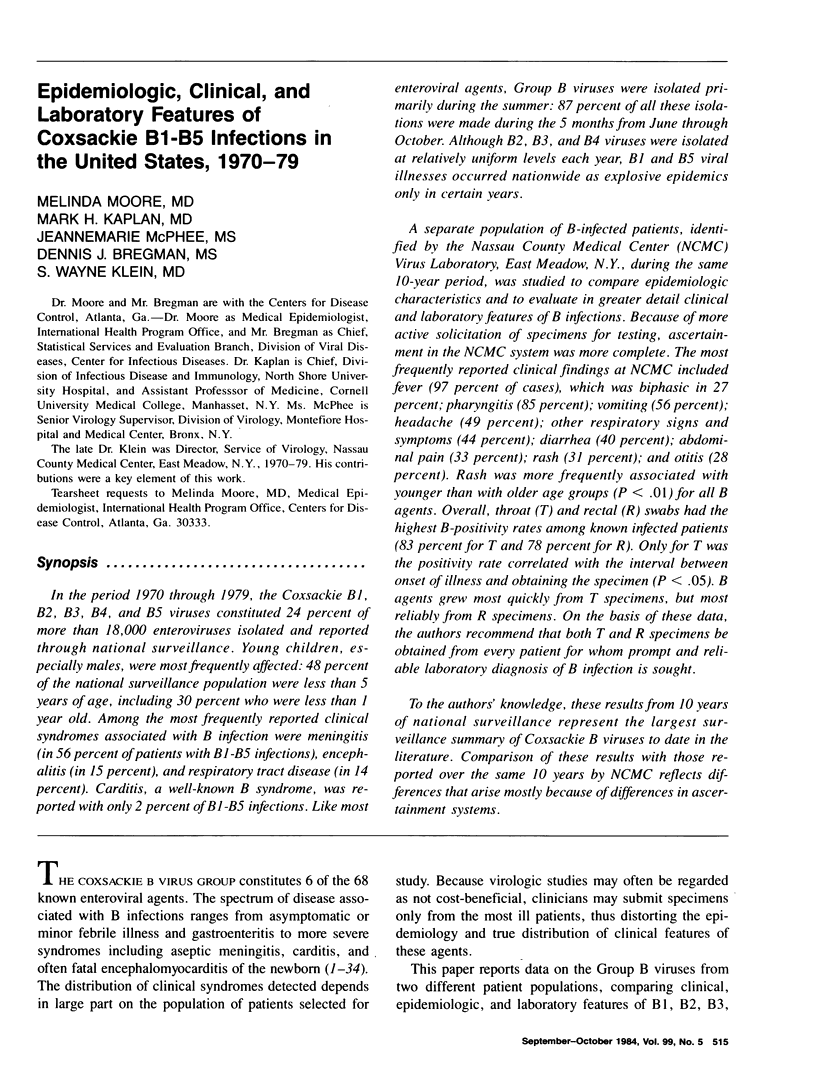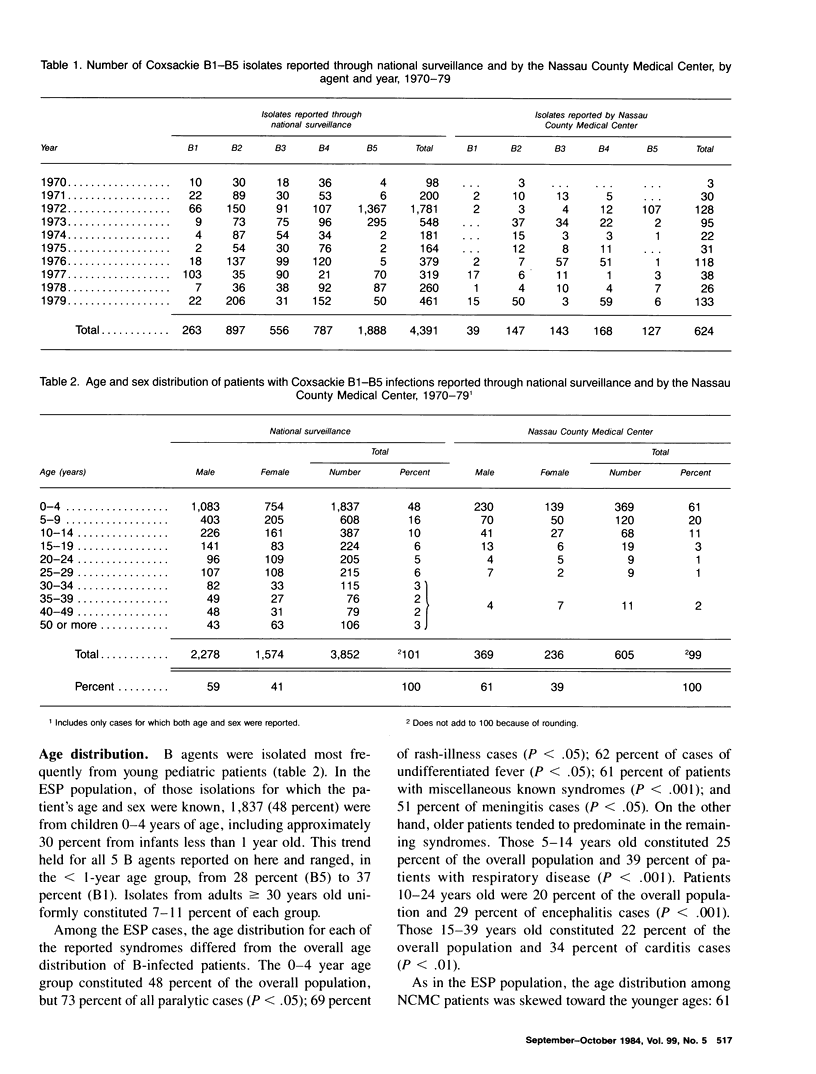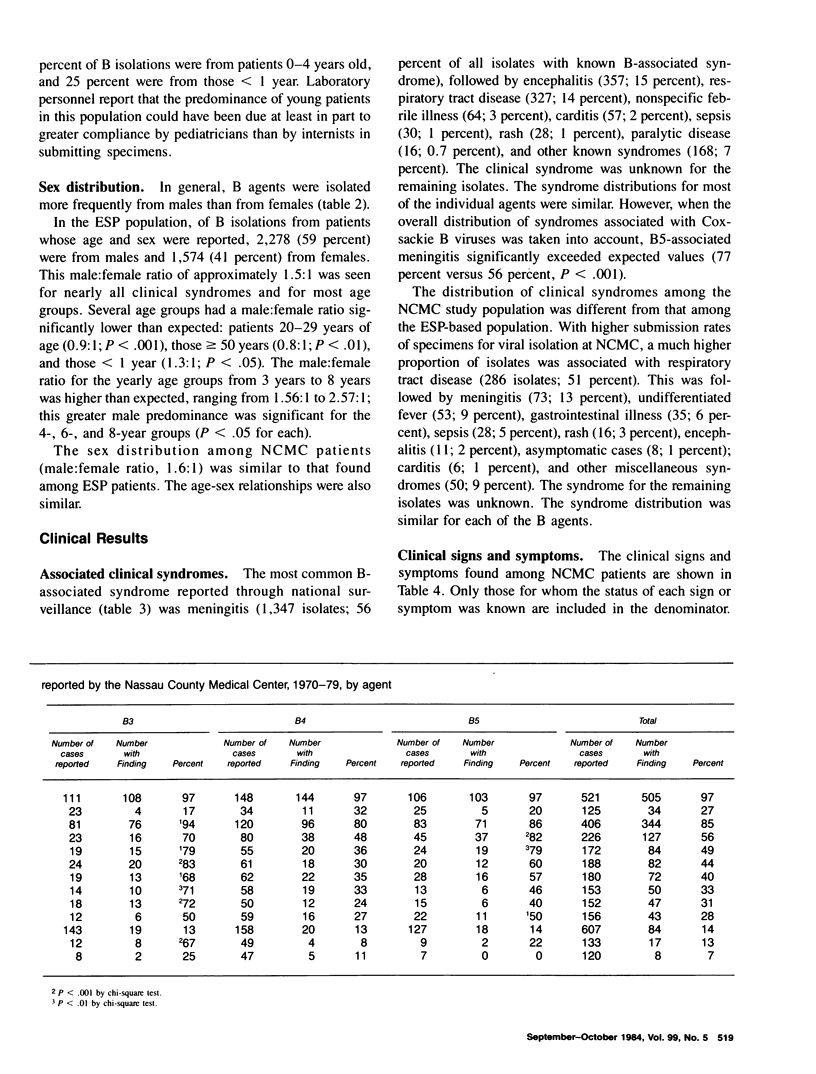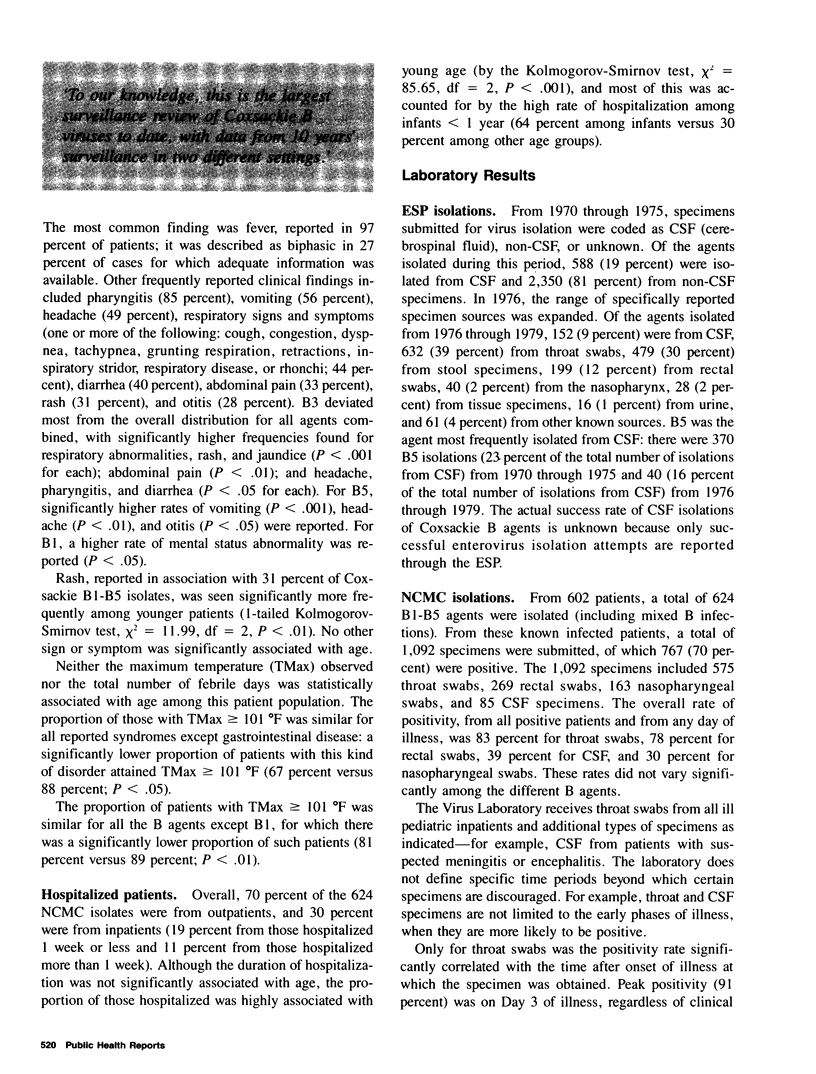Abstract
In the period 1970 through 1979, the Coxsackie B1, B2, B3, B4, and B5 viruses constituted 24 percent of more than 18,000 enteroviruses isolated and reported through national surveillance. Young children, especially males, were most frequently affected: 48 percent of the national surveillance population were less than 5 years of age, including 30 percent who were less than 1 year old. Among the most frequently reported clinical syndromes associated with B infection were meningitis (in 56 percent of patients with B1-B5 infections), encephalitis (in 15 percent), and respiratory tract disease (in 14 percent). Carditis, a well-known B syndrome, was reported with only 2 percent of B1-B5 infections. Like most enteroviral agents, Group B viruses were isolated primarily during the summer: 87 percent of all these isolations were made during the 5 months from June through October. Although B2, B3, and B4 viruses were isolated at relatively uniform levels each year, B1 and B5 viral illnesses occurred nationwide as explosive epidemics only in certain years. A separate population of B-infected patients, identified by the Nassau County Medical Center (NCMC) Virus Laboratory, East Meadow, N.Y., during the same 10-year period, was studied to compare epidemiologic characteristics and to evaluate in greater detail clinical and laboratory features of B infections. Because of more active solicitation of specimens for testing, ascertainment in the NCMC system was more complete. The most frequently reported clinical findings at NCMC included fever (97 percent of cases), which was biphasic in 27 percent; pharyngitis (85 percent); vomiting (56 percent); headache (49 percent); other respiratory signs and symptoms (44 percent); diarrhea (40 percent); abdominal pain (33 percent); rash (31 percent); and otitis (28 percent).(ABSTRACT TRUNCATED AT 250 WORDS)
Full text
PDF







Selected References
These references are in PubMed. This may not be the complete list of references from this article.
- ARTENSTEIN M. S., CADIGAN F. C., Jr, BUESCHER E. L. EPIDEMIC COXSACKIE VIRUS INFECTION WITH MIXED CLINICAL MANIFESTATIONS. Ann Intern Med. 1964 Feb;60:196–203. doi: 10.7326/0003-4819-60-2-196. [DOI] [PubMed] [Google Scholar]
- ASHKENAZI A., MELNICK J. L. Topics in microbiology. Enteroviruses--a review of their properties and associated diseases. Am J Clin Pathol. 1962 Sep;38:209–229. doi: 10.1093/ajcp/38.3.209. [DOI] [PubMed] [Google Scholar]
- Abelmann W. H. Virus and the heart. Circulation. 1971 Nov;44(5):950–956. doi: 10.1161/01.cir.44.5.950. [DOI] [PubMed] [Google Scholar]
- Artenstein M. S., Cadigan F. C., Jr, Buescher E. L. Clinical and epidemiological features of Coxsackie group B virus infections. Ann Intern Med. 1965 Oct;63(4):597–603. doi: 10.7326/0003-4819-63-4-597. [DOI] [PubMed] [Google Scholar]
- Assaad F., Cockburn W. C. Four-year study of WHO virus reports on enteroviruses other than poliovirus. Bull World Health Organ. 1972;46(3):329–336. [PMC free article] [PubMed] [Google Scholar]
- Bell E. J., Grist N. R. Further studies of enterovirus infections in cardiac disease and pleurodynia. Scand J Infect Dis. 1970;2(1):1–6. doi: 10.3109/inf.1970.2.issue-1.01. [DOI] [PubMed] [Google Scholar]
- Bennett N. M. Coxsackie B pericarditis. Med J Aust. 1966 Jul 23;2(4):178–179. doi: 10.5694/j.1326-5377.1966.tb73494.x. [DOI] [PubMed] [Google Scholar]
- Bennett N. M., Forbes J. A. Coxsackie pericarditis. Am Heart J. 1967 Sep;74(3):435–436. doi: 10.1016/0002-8703(67)90087-7. [DOI] [PubMed] [Google Scholar]
- Burch G. E., Sun S. C., Colcolough H. L., Sohal R. S., DePasquale N. P. Coxsackie B viral myocarditis and valvulitis identified in routine autopsy specimens by immunofluorescent techniques. Am Heart J. 1967 Jul;74(1):13–23. doi: 10.1016/0002-8703(67)90035-x. [DOI] [PubMed] [Google Scholar]
- Dery P., Marks M. I., Shapera R. Clinical manifestations of coxsackievirus infections in children. Am J Dis Child. 1974 Oct;128(4):464–468. doi: 10.1001/archpedi.1974.02110290034006. [DOI] [PubMed] [Google Scholar]
- Froeschle J. E., Feorino P. M., Gelfand H. M. A continuing surveillance of enterovirus infection in healthy children in six United States cities. II. Surveillance enterovirus isolates 1960-1963 and comparison with enterovirus isolates from cases of acute central nervous system disease. Am J Epidemiol. 1966 May;83(3):455–469. doi: 10.1093/oxfordjournals.aje.a120597. [DOI] [PubMed] [Google Scholar]
- GELFAND H. M., HOLGUIN A. H. Enterovirous infections in healthy children. Study during 1960. Arch Environ Health. 1962 Nov;5:404–411. doi: 10.1080/00039896.1962.10663305. [DOI] [PubMed] [Google Scholar]
- Grist N. R., Bell E. J. A six-year study of coxsackievirus B infections in heart disease. J Hyg (Lond) 1974 Oct;73(2):165–172. doi: 10.1017/s0022172400023998. [DOI] [PMC free article] [PubMed] [Google Scholar]
- Grist N. R., Bell E. J., Assaad F. Enteroviruses in human disease. Prog Med Virol. 1978;24:114–157. [PubMed] [Google Scholar]
- Grist N. R., Bell E. J. Coxsackie viruses and the heart. Am Heart J. 1969 Mar;77(3):295–300. doi: 10.1016/0002-8703(69)90184-7. [DOI] [PubMed] [Google Scholar]
- HORSTMANN D. M. Acute poliomyelitis relation of physical activity at the time of onset to the course of the disease. J Am Med Assoc. 1950 Jan 28;142(4):236–241. doi: 10.1001/jama.1950.02910220016004. [DOI] [PubMed] [Google Scholar]
- HORSTMANN D. M. Poliomyelitis: severity and type of disease in different age groups. Ann N Y Acad Sci. 1955 Sep 27;61(4):956–967. doi: 10.1111/j.1749-6632.1955.tb42554.x. [DOI] [PubMed] [Google Scholar]
- Hirschman S. Z., Hammer G. S. Coxsackie virus myopericarditis. A microbiological and clinical review. Am J Cardiol. 1974 Aug;34(2):224–232. doi: 10.1016/0002-9149(74)90201-x. [DOI] [PubMed] [Google Scholar]
- KIBRICK S. CURRENT STATUS OF COXSACKIE AND ECHO VIRUSES IN HUMAN DISEASE. Prog Med Virol. 1964;6:27–70. [PubMed] [Google Scholar]
- Kogon A., Spigland I., Frothingham T. E., Elveback L., Williams C., Hall C. E., Fox J. P. The virus watch program: a continuing surveillance of viral infections in metropolitan New York families. VII. Observations on viral excretion, seroimmunity, intrafamilial spread and illness association in coxsackie and echovirus infections. Am J Epidemiol. 1969 Jan;89(1):51–61. doi: 10.1093/oxfordjournals.aje.a120915. [DOI] [PubMed] [Google Scholar]
- Lerner A. M. An experimental approach to virus myocarditis. Prog Med Virol. 1965;7:97–115. [PubMed] [Google Scholar]
- Lerner A. M., Wilson F. M. Virus myocardiopathy. Prog Med Virol. 1973;15:63–91. [PubMed] [Google Scholar]
- Moore M. Centers for Disease Control. Enteroviral disease in the United States, 1970-1979. J Infect Dis. 1982 Jul;146(1):103–108. doi: 10.1093/infdis/146.1.103. [DOI] [PubMed] [Google Scholar]
- RUSSELL W. R. Poliomyelitis; the pre-paralytic stage, and the effect of physical activity on the severity of paralysis. Br Med J. 1947 Dec 27;2(4538):1023–1028. doi: 10.1136/bmj.2.4538.1023. [DOI] [PMC free article] [PubMed] [Google Scholar]
- SANDERS V. VIRAL MYOCARDITIS. Am Heart J. 1963 Nov;66:707–713. doi: 10.1016/0002-8703(63)90328-4. [DOI] [PubMed] [Google Scholar]
- Sainani G. S., Dekate M. P., Rao C. P. Heart disease caused by Coxsackie virus B infection. Br Heart J. 1975 Aug;37(8):819–823. doi: 10.1136/hrt.37.8.819. [DOI] [PMC free article] [PubMed] [Google Scholar]
- Schmidt N. J., Magoffin R. L., Lennette E. H. Association of group B coxsackie viruses with cases of pericarditis, myocarditis, or pleurodynia by demonstration of immunoglobulin M antibody. Infect Immun. 1973 Sep;8(3):341–348. doi: 10.1128/iai.8.3.341-348.1973. [DOI] [PMC free article] [PubMed] [Google Scholar]
- Smith W. G. Coxsackie B myopericarditis in adults. Am Heart J. 1970 Jul;80(1):34–46. doi: 10.1016/0002-8703(70)90035-9. [DOI] [PubMed] [Google Scholar]
- TILLES J. G., ELSON S. H., SHAKA J. A., ABELMANN W. H., LERNER A. M., FINLAND M. EFFECTS OF EXERCISE ON COXSACKIE A9 MYOCARDITIS IN ADULT MICE. Proc Soc Exp Biol Med. 1964 Dec;117:777–782. doi: 10.3181/00379727-117-29696. [DOI] [PubMed] [Google Scholar]
- Wenner H. A. The enteroviruses. Am J Clin Pathol. 1972 Jun;57(6):751–761. doi: 10.1093/ajcp/57.6.751. [DOI] [PubMed] [Google Scholar]
- Whitehead J. E. Silent infections and the epidemiology of viral carditis. Am Heart J. 1973 May;85(5):711–713. doi: 10.1016/0002-8703(73)90181-6. [DOI] [PubMed] [Google Scholar]
- Windorfer A., Sitzmann F. C. Die akute Virusmyokarditis im Säuglingsund Kindesalter. Dtsch Med Wochenschr. 1971 Jul 9;96(28):1177–1184. doi: 10.1055/s-0028-1110102. [DOI] [PubMed] [Google Scholar]
- Woods J. D., Nimmo M. J., Mackay-Scollay E. M. Adult heart disease associated with coxsackie B virus infection. Med J Aust. 1973 Sep 22;2(12):573–577. doi: 10.5694/j.1326-5377.1973.tb129669.x. [DOI] [PubMed] [Google Scholar]


